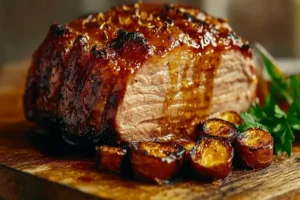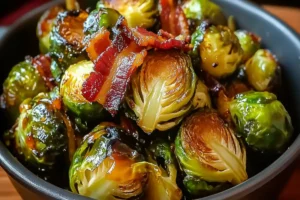Introduction
The smell of baked ham fills your home, bringing back memories. It's a time to gather and share laughter and love. Homemade ham gravy is a key part of this tradition, making your meal unforgettable. Learning to make ham gravy is a valuable skill. It's perfect for special occasions or when you just want a taste of comfort. With a few ingredients and some technique, you can turn leftover ham drippings into a delicious sauce. Let's explore how to make the perfect gravy together.
Table of contents
Understanding the Basics of Ham Gravy
Ham gravy is a rich, savory sauce loved with baked ham and other dishes. It’s made from ham drippings, butter, flour, and cream or milk. This homemade gravy brings a flavor depth that store-bought can’t match, making it a favorite in Southern and country kitchens.
What is Ham Gravy?
Ham gravy is a pork gravy made from ham drippings. It’s a creamy sauce that goes well with ham’s salty-sweet taste. Making it involves deglazing the pan and thickening it with butter and flour roux.
Why Make Homemade Ham Gravy?
Making your own homemade gravy lets you choose the ingredients and flavor. Store-bought southern gravy or country gravy might have preservatives. But homemade uses fresh ingredients, making it richer and more flavorful.
Homemade gravy is great for holiday hams or as a topping for mashed potatoes. It’s a delicious choice that’s worth making.
Essential Ingredients for Ham Gravy
Making the perfect gravy starts with knowing the key ingredients. You need ham drippings, butter, all-purpose flour, and heavy cream. For the best taste, use drippings from a fresh ham. But, processed ham works too if you don’t have fresh.
Choosing the Right Cooking Fat
The roux, which thickens the gravy, is made with butter. But, you can also use turkey fat or bacon grease. Each fat adds a special taste. Make sure to use the same amount of butter and flour for the right consistency.
Must-Have Spices and Seasonings
- Black Pepper adds heat and depth to the gravy.
- Adding a splash of Worcestershire sauce or a drizzle of vinegar boosts flavor.
The secret to great gravy is balancing these ingredients. By getting the right mix, you’ll make a gravy that’s rich and velvety. It will surely please your taste buds.
| Ingredient | Quantity |
|---|---|
| Unsalted Butter | 4 tablespoons (58g) |
| All-Purpose Flour | 1/4 cup (32g) |
| Warm Stock or Pan Drippings | 3 cups |
| Heavy Cream (optional) | 2 to 3 tablespoons |
| Mushroom Powder (optional) | 1/2 teaspoon |
| Fresh or Dried Herbs | 1/2 tablespoon chopped or 1/2 teaspoon dried |
"The secret to a perfect ham gravy lies in the balance of its essential components – the rich, savory drippings, the creamy butter, and the thickening power of flour."
With these ingredients ready, you’re set to make a ham gravy that will take any meal to the next level.
Preparing the Ham for Gravy
Creating the perfect ham gravy begins with picking the right ham. Opt for a quality baked ham, like a country ham, spiral-sliced ham, or honey-baked ham. These hams are full of rich, savory flavors that will make your gravy taste amazing.
To make your gravy even better, use the ham drippings wisely. While the ham roasts, add some unsalted stock or water to the pan. This trick stops the drippings from burning and boosts the flavors. Remember to use a rubber spatula to get every bit of flavor from the pan.
Cooking Techniques to Enhance Flavor
- Baste the ham often while it’s roasting. This keeps it moist and adds to the gravy’s flavor.
- Let the ham rest for 15-20 minutes before slicing. This step makes the juices spread out, making the ham even more flavorful.
- Remove any extra fat from the ham before cooking. The ham drippings are crucial for a tasty gravy, so you want as much as possible.
By choosing the right ham and using these cooking tips, you’ll have a great base for an amazing baked gravy. Your family and friends will surely enjoy it.
Steps to Make Perfect Ham Gravy
Making delicious gravy is easier than you think. Just follow a few simple steps to make a rich, tasty sauce that goes well with ham. Here’s how to get the perfect gravy.
Step-by-Step Cooking Instructions
- Start by melting butter in a saucepan over medium heat. This is the base for your roux, which makes the gravy smooth.
- Whisk in flour, stirring constantly until it turns golden. This whisking step is key for a smooth roux.
- Slowly add the ham drippings while whisking. These drippings add a rich flavor to the gravy.
- Let the mix simmer until it thickens, usually 5-10 minutes. Keep the heat low to avoid burning.
- Stir in heavy cream or milk and seasonings like salt, pepper, or Dijon mustard. This makes the gravy silky and balanced.
Tips for Achieving the Right Consistency
To get a smooth gravy, whisk constantly when adding ham drippings. Adding liquid slowly helps avoid lumps. If it’s too thick, add more drippings or stock. If it’s too thin, make a cornstarch slurry and whisk it in until it’s right.
“The secret to a perfect ham gravy lies in the balance of a rich, flavorful roux and the gradual addition of savory drippings.”
Flavor Variations for Your Ham Gravy
It’s easy to make your homemade gravy taste amazing. Just add a few simple ingredients to turn it into a dish that will wow you.
Adding Sweetness with Maple Syrup
Try adding a bit of pure maple syrup to your gravy for sweetness. This syrup adds a rich, caramel flavor. Start with a tablespoon and adjust to taste.
Incorporating Spicy Elements
Want a bit of heat? Add brown sugar or a splash of red wine to your gravy. The sugar adds depth, while the wine brings a subtle earthy flavor. For more heat, try a pinch of cayenne or black pepper.
Using a cornstarch slurry to thicken the gravy is another great idea. It not only thickens but also lets you add bold flavors like horseradish or Dijon mustard.
Remember, the secret to the best gravy is to have fun and try new things. Don’t be afraid to mix and match ingredients. Your taste buds will love it!
Common Mistakes to Avoid
Making the perfect gravy is an art. It’s important to avoid common mistakes to get a delicious result. One big mistake is making the gravy too thick. Adding flour directly to hot liquid can cause lumps.
To avoid this, mix the flour or cornstarch with a bit of cold liquid first. Then, slowly whisk it into the hot gravy. This method keeps the gravy smooth and free of lumpy gravy.
Another mistake is skipping the step of deglazing the roasting pan. This step adds flavor and captures all the tasty bits from cooking the ham. Make sure to scrape up every bit, as they are key to a great gravy.
When seasoning, taste the gravy before adding more salt. Ham drippings can make the gravy too salty. Start with a small amount of seasoning. If it’s too salty, a squeeze of lemon or sour cream can fix it.

By avoiding these mistakes and following best practices, you’ll make a ham gravy fit for any holiday. With attention to detail and focus on seasoning balance, your homemade gravy will impress everyone.
Pairing Ham Gravy with Dishes
There are countless ways to enjoy homemade ham gravy. It goes great with mashed potatoes, green bean casserole, and biscuits and gravy. The gravy’s rich taste makes these dishes even better.
Best Side Dishes to Serve with Ham Gravy
- Creamy mashed potatoes – The gravy’s smooth texture and salty-sweet notes balance beautifully with the starchy potatoes.
- Green bean casserole – The earthy, tender green beans soak up the flavors of the ham gravy, creating a harmonious dish.
- Fluffy biscuits and gravy – A classic pairing where the biscuits become the perfect vehicle for the rich, savory gravy.
- Buttery cornbread stuffing – The gravy’s robust flavors complement the cornbread’s sweetness and crumbly texture.
- Roasted root vegetables – Carrots, parsnips, and potatoes become even more delectable when coated in the flavorful ham gravy.
Creative Uses for Leftover Gravy
Don’t waste leftover ham gravy! Use it as a base for soups and stews. Or, top sandwiches and burgers for extra flavor. You can also mix it into casseroles or use it as a dipping sauce for roasted vegetables or bread. The possibilities are endless.
"The rich, savory flavors of ham gravy pair beautifully with a wide range of side dishes, elevating comfort food classics to new heights."
Serving Suggestions for Ham Gravy
Make your holiday table shine with homemade ham gravy. Serve it in a warm gravy boat for a touch of elegance. It’s perfect for dressing up sliced ham or as a tasty side dish.
Presentation Tips
Pour the ham gravy into a gravy boat for a beautiful display. Add some fresh parsley or chives on top for color and freshness. This simple touch will make your table feel fancy.
Recommended Accompaniments
- Roasted veggies like Brussels sprouts or carrots go great with ham gravy.
- Creamy mashed potatoes or sweet potato casserole are perfect for this gravy.
- Try serving ham gravy with cranberry sauce for a sweet and savory mix.
- For a comfort food twist, pour it over buttermilk biscuits or use it for dipping.
Homemade ham gravy will wow your guests and make your holiday meal special.

Storing and Reheating Ham Gravy
Storing and reheating your homemade ham gravy right is key to keeping its taste and texture. Follow these easy tips to keep your leftover gravy fresh and ready to enjoy.
Proper Storage Techniques
Leftover gravy can stay in the fridge for up to 4 days in an airtight container. For longer storage, freeze it for up to 3 months. Use a freezer-safe container to avoid freezer burn and keep the flavor.
How to Reheat without Losing Flavor
To reheat frozen gravy, thaw it in the fridge overnight. Then, heat it gently on the stovetop or in the microwave, stirring often. If it gets too thick, add a bit of broth or cream to thin it out.
Heat the gravy until it simmers and reaches the right consistency, usually in 1-2 minutes of constant stirring. Remember, reheated gravy should be eaten within 4 days after thawing. Don’t refreeze it, as it can affect the texture and taste. With these tips, you can enjoy your homemade gravy anytime.
Frequently Asked Questions About Ham Gravy
Exploring homemade gravy can raise some questions. Let’s tackle some common ones to help you make the perfect gravy every time.
Can I Freeze Ham Gravy?
Yes, you can freeze gravy! It’s perfect for making ahead. Cool the gravy, then put it in an airtight container or freezer-safe bag. It stays good in the freezer for up to 2 months.
To use, thaw it in the fridge overnight. Then, reheat it on the stovetop until it’s warm.
How to Modify for Dietary Restrictions
Ham gravy can be adjusted for different diets. For a gluten-free gravy, use cornstarch instead of flour. To cut down on sodium, choose low-sodium broth and unsalted butter.
For a dairy-free or vegan alternative, swap in plant-based milk and margarine. This way, everyone can enjoy the rich flavors of homemade ham gravy, no matter their dietary needs.

"The versatility of ham gravy is truly amazing. I love that I can customize it to suit my family's preferences, whether that's gluten-free, low-sodium, or vegan."
Conclusion: Enjoying Your Homemade Ham Gravy
Homemade gravy is a great way to make holiday meals and comfort food even better. It brings together traditional tastes and lets you get creative in the kitchen. Whether it’s for a big family dinner or a cozy night in, gravy can make any meal special.
Celebrating Traditional Flavors
Homemade gravy brings back memories of family traditions and the warm tastes of the American South. Making your own gravy lets you enjoy the real taste of this classic comfort food. It’s a joy to share this dish with the people you love.
Encouragement to Experiment with Recipes
While traditional recipes are tasty, don’t be afraid to try new things. Mix up different spices, liquids, and cooking ways to make your ham gravy unique. Letting your creativity shine can lead to exciting new flavors and make your dish truly yours.
FAQ
Can I freeze ham gravy?
Yes, you can freeze ham gravy for up to 2 months. Just make sure to store it in an airtight container.
How can I modify ham gravy for dietary restrictions?
For a gluten-free version, use cornstarch instead of flour. This will help thicken the gravy without gluten.
To cut down on sodium, choose low-sodium broth and unsalted butter. If you’re looking for a dairy-free option, swap out regular milk and butter for plant-based alternatives.
Vegans can also make their own version using vegetable broth and plant-based thickeners. Keep in mind, it won’t taste exactly like traditional ham gravy.







2 thoughts on “5 Easy Steps to Make Perfect Ham Gravy”